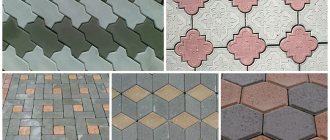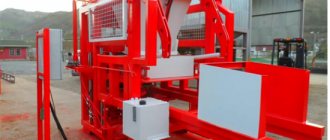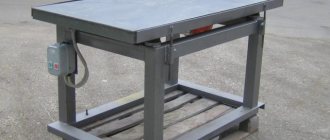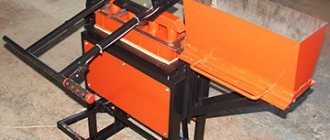Tiles are widely used for arranging sidewalks and garden paths. To save money, it is recommended to cast the tracks yourself. For this purpose, forms, concrete mixture and lubricant are used. The concrete mixture is made from cement, sand, dye, fine gravel and plasticizer. You can purchase molds for making paving slabs at a specialized store. To prevent the concrete mixture from sticking to the forms during the work, it is recommended to use a lubricant for paving slab forms.
Types of lubricants
To make tiles, specialized lubricants can be used, which are sold in hardware stores. You also have the opportunity to independently prepare special equipment from:
- Oils;
- Salts;
- Soap.
Application of oil solution
carried out with an ordinary sponge. Thanks to this composition, it is as easy as possible to remove finished products from molds, and the containers themselves do not become dirty. The material has a low cost, which ensures its availability. When using dark oil, there may be a change in the color of the tile.
In saline solution
You need to pre-soak the molds. The advantage of lubricant is that finished products are easily removed from the molds, but the disadvantage is the possibility of streaks appearing on the paving stones.
Soap solution
used for lubricating molds before pouring concrete. Despite good sliding properties, mold contamination occurs when using this material.
What to lubricate the molds for paving slabs with is determined by the user depending on their goals and financial capabilities.
What to lubricate with?
Experienced builders advise choosing a lubricant based on the molds and mixture for making slabs.
Before choosing a lubricant for concrete tiles, you need to understand that a good lubricant during use should not paint the poured building material and affect the appearance and characteristics of the concrete. The choice of lubricants is large and varied. Common types of lubricants:
- Salt mixture. To begin with, the mixture is diluted with water, and only after that concrete is poured into it. The low cost of building material is a plus. The downside is that the material is difficult to wash off from the surface of the tiles and leaves behind salt traces.
- Engine oil. Easy to apply and apply to the surface of the slab. This lubricant should be spread using foam rubber or a sponge. The cost of such material is low, and after use the oil can be easily washed off from the surface. The downside is that stains remain on the surface and the coating becomes less attractive in appearance.
- Soap mixture. The solution is made from soap and water and is easy to apply using a cloth or foam sponge. It is possible to cook at home and does not require a lot of time and money. The forms are difficult to clean after use and remain dirty.
- Emulsol. This product is mixed with water, usually in a ratio of 1 to 3 or 1 to 5, it depends on the volume of work and the material itself. Easy to apply with a construction brush. It is an excellent tool for lubricating molds with delicate patterns that a sponge often cannot reach.
Lubricant properties
In order to determine how to lubricate molds for paving slabs, you need to familiarize yourself with the characteristics of the compositions.
When choosing a lubricant, you need to ensure that it strictly meets the requirements:
- With a high quality composition, the possibility of distortion of the shape and color of paving slabs is eliminated.
- To carry out the manipulation, you need to use only liquid compounds, since they must be applied in as thin a layer as possible.
- The lubricant should not have pores that allow air to pass through.
- The material should ensure the easiest possible removal of the finished tile.
- When choosing a lubricant, you need to ensure that it does not affect the color and shape of the finished product.
- After applying the lubricant, there should be no traces left on the tiles.
- Water or an inexpensive solvent should be used to dissolve the composition.
The characteristics of lubricants must be taken into account, which will have a positive effect on the characteristics of the tile.
Popular lubricants and their manufacturers
In monolithic construction, various types of lubricants for formwork, produced domestically and abroad, are used. The most popular lubricants are the following brands:
- Angrol . Produced in Russia (“KhimStroySnab” and others). It is an aqueous emulsion with sodium sulfate, organic matter and emulsifying additives. Density - from 800 to 950 kg/cubic m. Operating temperature is –15...+70 °C. Complies with fire safety standards and has no unpleasant odor.
- Emulsol . Produced by Russian companies, Eleosstroy, others). This is a water-repellent lubricant based on surfactants and mineral oils with the addition of polyethylene glycol and alcohol. Density - from 870 to 950 kg/cu m. Operating temperature is -15...+16 °C (EKS-IM Emulsol variety - up to -35 °C). There are also compositions EKS (for reinforcement-free formwork), EKS-2 (for metal structures) and EKS-A (universal value, economical consumption, absence of greasy stains, contains anti-corrosion additives).
- Tiralux . Produced by the Russian company Tira Lux under a German license. Contains antifreeze additives and mineral oils. Density is about 880 kg/cu.m. m, operating temperature - from –18 to +70 degrees Celsius.
- Agate . Ukrainian analogue of lubricants of foreign origin. Its density is 875–890 kg/cubic. m. The operating temperature is –25…+80 оС. It is an oil-based emulsion without water that can be used for all types of formwork. Does not leave greasy marks on concrete.
Do-it-yourself paving slabs: the manufacturing process at home
To reduce the cost of manufacturing paving slabs, it is recommended to carry out this procedure yourself. In order to make high-quality tiles, it is recommended to use the vibration casting method. This will ensure a dense structure of the concrete mixture, which will have a positive effect on the quality of the tiles and their service life.
Step-by-step description of the process at home
At the initial stage, you need to prepare all the tools and materials. The work is carried out using:
- Concrete mixers.
- Vibrating table.
- Racks for storing molds.
Warm water is collected in the container. They are necessary for removing finished products from molds. You also need to take care of purchasing or making the molds themselves.
At the preparatory stage, a person must prepare a solution from ½ part sand, 1/5 cement, ¼ granotsev, 1/100 plasticizer, 7/100 dye, 1/20 water. All components are placed in a concrete mixer and mixed thoroughly. The plasticizer is first dissolved in a small amount of water. Sand is added to the mixture, and at the final stage - cement. In order to effectively mix the composition, you need to periodically add water to the concrete mixer.
The following is a step-by-step implementation of the work:
- Initially, the forms are prepared. If new devices are used, then no work is performed at this stage. Old molds that have already been used must be cleaned.
- Before pouring the concrete mixture, the surface of the molds is lubricated with the selected composition.
- At the next stage, the prepared concrete of the required consistency is poured into molds.
- Molds with concrete should be shaken slightly and placed on a vibrating table. When a white film appears on the surface, the molds are removed. If two-color paving stones are made, then compaction of each layer is carried out separately.
- The molds are placed on the surface until the solution dries completely. To avoid cracking of the concrete mixture, it is recommended to periodically spray the surface with water.
At the final stage, you need to pull the finished tiles out of the molds. To do this, the tile along with the mold is lowered into a container of water, the temperature of which is 60 degrees. Due to the effect of heat on the mold, it expands, which will facilitate the process of drawing out the tiles.
DIY mold lubricant
You can lubricate paving slab molds at home using a mixture that you prepare yourself.
In order to prepare the composition, you need to take liquid soap and dissolve it with water in a ratio of 1:3.
When making tiles, it is allowed to use a lubricant based on machine oil. This product is mixed with water in a ratio of 1:5. The proportion is determined depending on the desired density of the final material. In order for the composition to be homogeneous, it is mixed using a high-speed mixture or emulsion.
Saline solution is also used to lubricate molds. Its universal composition eliminates the possibility of the composition sticking to the form. You need to dissolve 1 pack of table salt in a bucket of water. In order for the liquid to completely dissolve, it is heated. But, only a cold solution should be used for application to the surface.
How to lubricate?
The method of applying the lubricant directly depends on its consistency. Liquid aqueous mineral compositions are applied using a sprayer. You can simply dip the molds in grease. The oil is applied using a brush or foam sponge.
During the period of work, you need to ensure that the inner surface of the mold is completely covered with the composition. That is why the molds are greased 2 times at a 20-minute interval. This will ensure even distribution of the composition. It will completely cover the surface of the mold. Before applying the mixture, the molds are cleaned and dried thoroughly.
If a homemade composition is used, then a test is first made on 1-2 tiles. If the quality is satisfactory, then this technology is used for the production of tiles.
Lubricate the plastic
Plastic molds are lubricated with a brush or spray. In this case, it is recommended to use oil formulations. The molds are first cleaned of debris and dust. Next, the lubricating mixture is applied. It is characterized by safety, so there is no need to use specialized suits. To protect your hands from contamination, it is recommended to wear gloves. If the spray method is used, it is recommended to wear a respirator.
The mold must be processed as carefully as possible so that all corners and crevices are filled with lubricant.
When using plastic containers, it is recommended to use lubricants based on biodegradable elements. They are characterized by efficiency and safety in operation. Such compositions are easily lubricated with water. Lubricant does not affect the rate of concrete hardening.
Fill
After lubricating the molds, the concrete mixture is poured into them. Initially, a small amount of solution is poured into the mold and distributed over its entire area. Next, the mold is filled to the top with cement mixture. During work, care must be taken to ensure that grease stains do not form on the surface of the concrete.
The form should be greasy, which will ensure high-quality sliding of the product over the surface. If grease is used in excessive quantities, it will cause depressions in the tiles. If there is not enough lubrication, this will complicate the process of pulling out the finished tiles.
Effective cleaning methods
Getting rid of large residues
As a rule, especially large remnants of tiles remain in the corners and on the edges. There is no way to get rid of such elements except with the help of solid objects. Here you can use a scraper, spatula and similar tools. The main thing is that they are not sharp, and perform all work as carefully as possible to reduce the likelihood of damage to a minimum.
We remove minor dirt
Minor stains are removed using chemicals, namely a solution of hydrochloric acid. It is prepared at the rate of 1:10. To clean, simply pour a small amount of solution into the mold and remove dirt using a small brush with long bristles (allows you to easily reach dirty places in the corners). After cleaning, lower the mold into a pre-prepared container with clean water. The brine solution can be used for subsequent cleaning by pouring from one mold to another.
Note! Working with saline solution requires compliance with safety measures: protect the respiratory tract with a respirator or gauze bandage, wear thick clothing and rubberized gloves.
The secret of beautiful tiles
Making paving slabs requires using the appropriate mold. It is sold in specialized stores and can have a variety of contours. If there is a need to create unique beautiful tiles, then you can use a variety of available forms. Food containers are an ideal option. They are characterized by softness and flexibility, which will facilitate the process of removing the finished tiles.
You can make tiles of a specific color. For this purpose, the use of various inorganic pigments is recommended. When choosing a dye, you should give preference to those options that are characterized by resistance to alkaline environments and negative environmental influences. When choosing such a dye, the tiles will retain an attractive appearance for a long time.
During the preparation of the solution, 30 to 50 grams of dye are added to it. If necessary, you can add a little more dye to obtain a rich color. The solution is thoroughly mixed until a uniform color is obtained and only then poured into molds. Before using the solution, you need to make sure that there are no lumps in it.
Available application options
This method is available to everyone and makes it possible to create a slab of exactly the shape and size that we need. In order to create it, you will need concrete.
When making it, you can use the “clumsy” method, mixing with a shovel in a trough. But this is a very labor-intensive process that takes a lot of time. It is better to use a concrete mixer that you can buy, rent or borrow. Do not forget to add a plasticizer to the mixture; if it is dry, then it must be dissolved in water.
And to obtain tiles of various colors, acrylic paints are added to concrete, so you can create tiles not only of any shape, but also of any color. The paint must be mixed with sand before adding it to the mixture.
To obtain tiles of various colors, acrylic paints are added to concrete, so you can create tiles not only of any shape, but also of any color.
- In addition to concrete, you will also need forms, which can be purchased in specialized stores; the most convenient are forms made of rubber and polymer. But you can also make them yourself.
For example, make frames from hewn wooden blocks. In this case, the shape will depend solely on your imagination and skillful hands. However, to create a drawing, you still have to go to the store to purchase a stencil to your liking. The stencil is applied to the concrete as soon as it is poured into the mold and removed after a few minutes.
Return to contents
Let's compare the efficiency
Making tiles yourself is more efficient than buying finished products. This is explained by the fact that a person is confident in the high quality of the building material. A specialist can make paving slabs at any time convenient for him. It is possible to add various pigments to the solution, which will allow you to obtain an original color and create a unique landscape design.
When choosing a lubricant, you must first determine its characteristics.
Used motor oil is effective and has a low cost. If you use a salt solution, the solution may remain on the surface of the tile. If a soap solution is used, the tile can be easily removed, but the mold remains dirty. It is best to use emulsol formwork product, which does not contaminate the tiles and molds.
Manufacturing methods
In practice, two main methods are used. First, let's get acquainted with the nuances of obtaining the material in question using the vibration casting method. This method is characterized by its comparative cheapness and the ability to obtain high-quality building materials even by inexperienced workers.
The technology for producing the material is as follows. The prepared working solution is poured into greased molds. Next, they are installed on a vibropress and compacted until air bubbles are released. Next, the raw material is placed on special racks for drying. After about two days, the tiles are knocked out of the molds and reused.
Paving stones made by vibrocompression differ from their analogues in improved resistance to mechanical stress and high strength. Such materials are intended for laying coatings in critical places, for example, car parks.
Note:
You can only make vibro-cast paving stones with your own hands, which can be used for constructing garden paths. Homemade materials cannot be used for a long time as a covering in places where vehicles are moving or parked.
The technology for producing vibropressed tiles is somewhat reminiscent of the work on producing tiles using the vibration casting method. The finished solution passes through a special press, so the products have improved strength indicators. At the final stage of work, the material is dried in special steaming chambers.
How to avoid bubbles?
Thanks to lubricant mixtures, the formation of bubbles is effectively combated. Most often, their formation is observed on the front side of paving slabs, which negatively affects the appearance. That is why it is recommended to use a lubricant before pouring concrete. In order to improve the quality of the lubricant, it is recommended to add a plasticizer to it, which will eliminate the possibility of bubbles.
The quality of the tile depends on the cement chosen. Therefore, it is recommended to give preference to fresh, not stale building material. When making colored tiles, the dye is diluted in advance.
Lubricant is a universal material that simplifies the process of pulling tiles out of molds and ensures their attractive appearance. You can buy it at the store or prepare it yourself.
Error 10. Improper drying
After pouring, the mold with tiles must be wrapped in film to maintain constant temperature and humidity and placed in a warm, but not sunny, place that is well protected from precipitation. The tiles can be removed from the mold after 2-3 days, but this does not mean that from that moment on they can be used to cover garden paths. It requires additional drying for 2-3 weeks. Paradoxically, in order to gain strength, concrete needs water. Therefore, if you dry the tiles in very hot weather, you can periodically gently moisten them.
Concrete prepared with M 500 cement reaches its maximum strength 28 days after casting. From this moment on, the tiles can be laid and used without fear
Did you like the article? Subscribe to the channel to stay up to date with the most interesting materials











